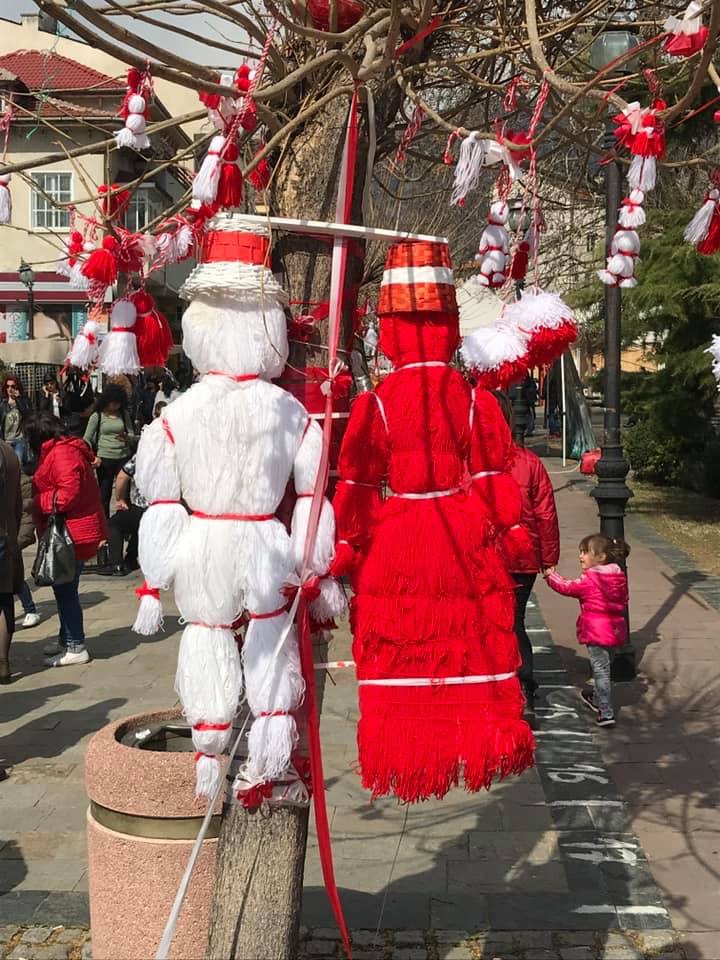The advent of spring was traditionally seen as a transition between the death of winter and new life and rebirth. Countless fertility rituals exist across the world to mark this important festival. Bulgaria is no exception with the spring celebration – Baba Marta. Various traditions still exist here with their roots hidden in misty paganism of centuries ago. Rituals for prosperity, good health, and fertility – as well as warding a way evil spirits!
Baba Marta
The first of March marks the celebration of Baba Marta (Grandma March) here in Bulgaria, and is seen as the first day of spring. Like many myths and legends, the origins of this particular one are unclear. However, it is thought to have its base in the various agricultural cult practices that proliferated in the Balkan mountains.

Baba Marta is personified as an unpredictable old woman – with mood swings between happy and angry – hence the weather fluctuations during this month! Alongside her appearance comes the wearing of Martenitsi.
Martenitsi
Martenitsi are red and white striped bracelets that are worn from the first day of March. People exchange these bracelets with each other on this day. These emblems are traditionally worn until the wearer sees either a tree bearing blossom, or their first stork. This is such a lovely tradition in that not only do friends award you with the traditional emblems, but also complete strangers and people you hardly know – like the man at the gas station. Once you see a stork or a tree in blossom, you are allowed to hang your bracelet on a nearby tree.

The Martenitsa is made of twined red and white threads – woollen, silk, or cotton. The white is a symbol of strength, purity and happiness.The red is associated with health, blood and conception. I’ve also heard that the white represents the melting snows of spring and the red the ever increasing heat of the Sun. Worn together the two colours symbolise rebirth.
Having looked a little deeper into this age old tradition it quite obviously has its roots in Paganism. Most articles link the custom with some kind of agricultural fertility ritual – similar to that of Baba Mata herself. Apparently, in some mountain areas even the cattle were adorned with Martenitsa. It is very common to also find them hung up in homes.

The legend behind these particular emblems dates right back to the formation of the Bulgarian state and its founder Khan Asparuh.
Pizho and Penda
The most typical Martenitsa to be exchanged on Baba Marta are red and white bracelets. Another favourite emblem contains two small wool dolls – Pizho and Penda. Pizho is the male doll, usually predominantly in white. Penda is the female doll, usually predominantly red and distinguished by her skirt.
The story goes that they once represented a real couple, immortalised in this decoration. The general consensus is that they represent a fertility symbol – male and female – joined together.



We celebrate Baba Marta in our village with the exchange of Martenitsa. But in the nearby town the celebrations are extended to incorporate traditional dance and also a performance by the Kukeri. Baba Marta is one of the most delightful days we look forward to each year since moving to Bulgaria.😊
Kukeri and Baba Marta
The Kukeri are yet another age-old tradition to be found in Bulgaria. Though I have seen them many times they never fail to fascinate me! There fierce masks and loud bells are meant to frighten away evil spirits! They often make an appearance during the festival of Baba Marta.
As with other famous ancient festivals, such as that of Venice, the origins are said to go back to Roman and Greek pagan traditions. Some believe even earlier than that – Thracian origins.
The masks are very elaborate and often contain pieces of broken mirror. The idea is that any evil spirit will be able to see their own face in the mirror and be frightened by it.


Very often, the men will tie heavy bells around their waist. They will then march in time or jump up and down to make a loud noise. However, other Kukeri look more like monsters or animals, wearing animal skins or long shaggy hair.
Each area has its own traditional dress. Great pride is taken in making and maintaining the costumes, and in keeping the tradition alive.
If you would like to learn more then this is a fascinating article.
Baba Marta Day



[…] begins on the first of March with the Baba Marta celebrations. People share woven bracelets of red and white. At the first sight of a stork or a […]
[…] Baba Marta […]
[…] begins on the first of March with the Baba Marta celebrations. People share woven bracelets of red and white. At the first sight of a stork or a […]
[…] Baba Marta – Rites of Spring […]